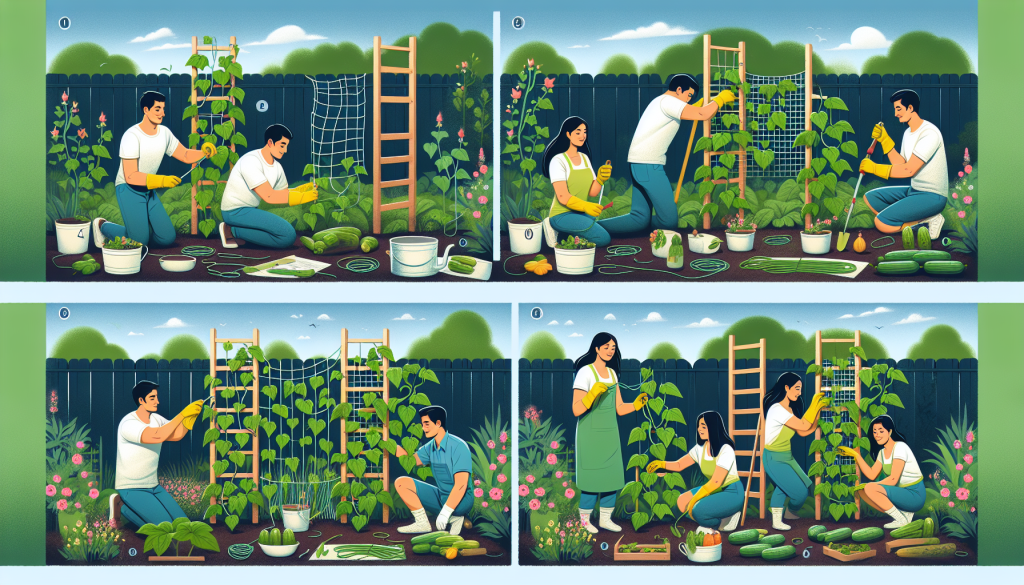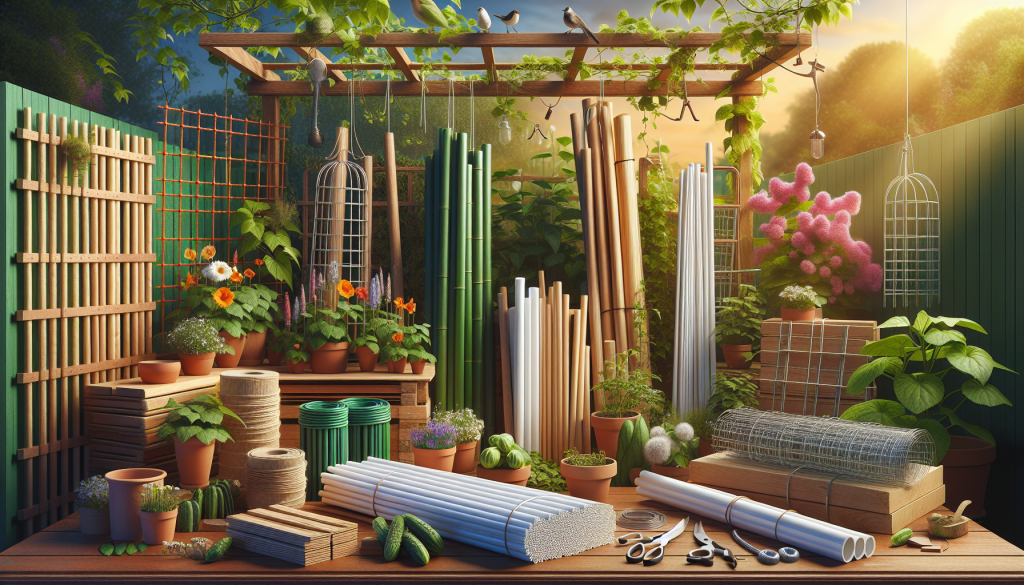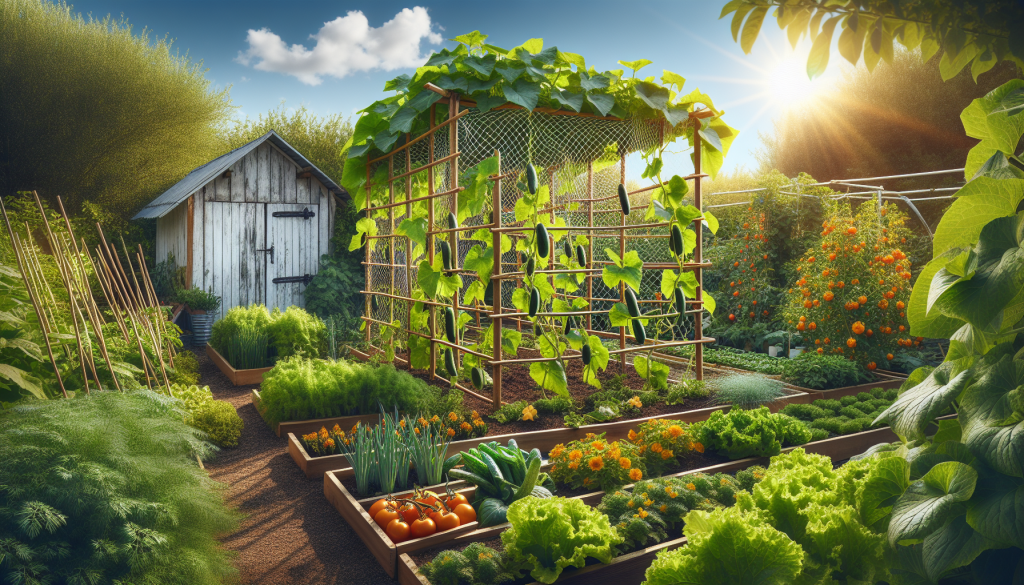All Posts
Unlock the Potential: DIY Cucumber Trellis for Bountiful Harvests
Why DIY Trellises Rock
Building your own cucumber trellis has a bunch of perks, especially if you’re into gardening. Knowing these benefits can help you get the most out of your garden and keep your plants happy and healthy.

Why Trellising Cucumbers is Awesome
Trellising cucumbers isn’t just for show; it actually makes your gardening life easier and your harvest bigger. According to Bonnie Plants, cucumbers on trellises are easier to pick and less likely to get sick. Here’s why:
- Space Saver: Trellised cucumbers use up less ground space, so you can grow more plants in a smaller area.
- Better Air Flow: Lifting the plants up improves air flow around the leaves and stems, cutting down on fungal infections (Real Simple).
- Easy Picking: Cucumbers hanging on a trellis are easier to spot and pick, making harvesting a breeze.
- Cleaner Fruits: Keeping cucumbers off the ground means they stay cleaner and don’t get all muddy (A Piece of Rainbow).
- More Cucumbers: Trellised vines often produce more cucumbers per square foot than those grown on the ground (Real Simple).
| Benefit | Why It’s Great |
|---|---|
| Space Saver | Uses less ground space |
| Better Air Flow | Cuts down on fungal infections |
| Easy Picking | Easier to spot and pick cucumbers |
| Cleaner Fruits | Keeps cucumbers off the ground |
| More Cucumbers | Higher yield per square foot |
Trellising Keeps Diseases at Bay
Trellising cucumbers can really help keep diseases away, leading to healthier plants and more cucumbers. By lifting the plants off the ground, trellising helps prevent soil-borne diseases and pests. Here’s how:
- Less Soil Contact: Trellising keeps cucumbers away from soil, reducing the risk of soil-borne diseases.
- Stops Leaf Diseases: Better air flow around the plants helps prevent diseases like powdery mildew and downy mildew (Real Simple).
- Fewer Pests: Raised plants are less likely to be attacked by soil-dwelling pests like potato bugs.
Building a DIY cucumber trellis can boost your garden’s productivity and keep your plants healthier by reducing disease risks. If you’re curious about different types of trellises for other plants, check out our articles on DIY tomato trellis, DIY pea trellis.

What You Need for DIY Trellises
Making a DIY cucumber trellis can be a fun project that leads to a great harvest. Picking the right materials is key for a strong and effective trellis. Here are some common and budget-friendly materials you can use.
Popular Materials for Trellises
There are several materials you can use to build trellises, each with its own benefits. These materials are easy to find and can fit different garden setups.
- Bamboo Poles: Bamboo is natural and sustainable, perfect for lightweight trellises. It’s easy to cut and put together.
- Wood: Wooden trellises are sturdy and can be made to any size. Common types of wood include furring strips and pallets.
- PVC Pipes: PVC is lightweight, durable, and weather-resistant. It works well with netting.
- Hardware Fencing: Chicken wire or cattle panels are great for supporting heavy vines. They’re strong and last many seasons.
Cheap Options for Trellises
You don’t need to spend a lot to build a trellis. Here are some budget-friendly materials and their costs:
| Material | Item | Cost |
|---|---|---|
| Netting | Vigoro 5’ x 8’ Trellis Netting | $3.75 |
| Wood | 2 in. x 2 in. x 8 ft Furring Strips | $3.98 each |
Figures courtesy Riley’s Garden.
For a 4’ x 8’ trellis, you’ll need three furring strips, and an extra strip if you want to expand to a 5’ x 8’ trellis. You can put it together with just four screws. Pre-drilling holes is optional, but a 1/8 inch drill bit can help.
Another cheap option is using recycled materials like old pallets or leftover PVC pipes. These can be repurposed to make a sturdy trellis without spending much.
For more creative ideas on building cheap trellises, check out our article on DIY vine trellis.
Picking the right materials and knowing their benefits can make building a DIY cucumber trellis easier. Whether you choose bamboo, wood, PVC, or hardware fencing, each option has its own perks to support healthy and productive cucumber plants.
Types of DIY Trellises
Making a DIY cucumber trellis can boost your garden’s productivity. There are several types of trellises you can build using different materials. Here we look at bamboo and wood trellises, PVC and netting trellises, and A-frame and teepee trellises.
Bamboo and Wood Trellises
Bamboo and wood trellises are popular for their natural look and strength. They can be made from bamboo poles, wooden stakes, or even repurposed pallets. These materials are strong enough to support climbing plants like cucumbers, making them perfect for a DIY cucumber trellis.
Why They’re Great:
- Natural look
- Strong and durable
- Easy to find materials
Common Materials:
- Bamboo poles
- Wooden stakes
- Pallets
| Material | Cost (per unit) | Durability (years) |
|---|---|---|
| Bamboo Poles | $1 – $3 | 3 – 5 |
| Wooden Stakes | $2 – $5 | 5 – 7 |
| Pallets | Free – $10 | 5 – 7 |
PVC and Netting Trellises
PVC pipes with nylon plant netting can make cheap and lightweight trellises. These trellises are easy to put together and take apart, making them a flexible option for seasonal gardening. The netting gives cucumber vines plenty of support to climb, ensuring a good harvest.
Why They’re Great:
- Lightweight and easy to move
- Cheap
- Easy to put together
Common Materials:
- PVC pipes
- Nylon plant netting
- Zip ties or clips
| Material | Cost (per unit) | Durability (years) |
|---|---|---|
| PVC Pipes | $1 – $2 | 5 – 10 |
| Nylon Netting | $5 – $10 | 3 – 5 |
For more info on using netting for your trellis, check out our article on DIY vine trellis.
A-Frame and Teepee Trellises
A-frame and teepee trellises are great for growing cucumbers. These structures give the vines plenty of space to climb, leading to more cucumbers and better use of space. Keeping cucumbers off the ground helps reduce disease and makes harvesting easier (Zion Family Homestead).
Why They’re Great:
- Makes good use of space
- Reduces disease risk
- Easier harvesting
Common Materials:
- Wooden stakes or poles
- Twine or wire
- Hardware fencing materials
| Material | Cost (per unit) | Durability (years) |
|---|---|---|
| Wooden Stakes | $2 – $5 | 5 – 7 |
| Hardware Fencing | $10 – $20 | 5 – 10 |
| Twine/Wire | $1 – $3 | 1 – 2 |
For more tips on building these trellises, visit our DIY Cucumber Trellis Tutorial.
By exploring these different types of DIY trellises, you can pick the one that best fits your gardening needs. Each type has its own perks and can help you get a great cucumber harvest.
Building a DIY Cucumber Trellis
Building a DIY cucumber trellis can be simple and rewarding. Here’s a step-by-step guide and a list of tools you’ll need to build a sturdy and effective trellis for your cucumber plants.
Step-by-Step Guide
To build a basic cucumber trellis, follow these steps:
- Gather Materials
- Vigoro 5’ x 8’ Trellis Netting ($3.75)
- 2 in. x 2 in. x 8 ft Furring Strips ($3.98 each)
- Four screws
- Cutting tool (saw or similar)
- Staple gun and staples
- Exacto knife or razor blade
- Cut the Furring Strips
- Cut two pieces of furring strip to the width of your raised bed (usually 4 feet or 8 feet).
- Assemble the Frame
- Lay out the furring strips on the ground to form a rectangular frame.
- Place a paver stone or piece of wood under each corner to keep the frame steady.
- Attach the furring strips using four screws. Pre-drilling holes can make this easier. A 1/8 inch drill bit is recommended.
- Attach the Trellis Netting
- Find the corners of the trellis netting, which will have two threads. Make sure every other connection point around the edge has only one thread.
- Staple the netting to the frame using a staple gun.
- Once all sides are secured, trim any extra netting using an Exacto knife or razor blade for a clean finish.
- Install the Trellis
- Stand the trellis frame vertically at the end of your cucumber rows or raised bed.
- Secure the frame by driving stakes into the ground and tying them to the frame for extra stability.
Tools You’ll Need
Here’s a list of tools you’ll need to build your DIY cucumber trellis:
| Tool | What It’s For |
|---|---|
| Saw | Cutting furring strips to size |
| Drill | Pre-drilling holes and driving screws |
| Drill Bit (1/8 inch) | Pre-drilling holes for screws |
| Staple Gun | Attaching trellis netting to the frame |
| Exacto Knife/Razor Blade | Trimming extra netting |
| Rubber Mallet | Securing stakes in the ground |
This simple assembly process means even beginners can build a functional and effective cucumber trellis. For more detailed projects, check out other types of trellises like DIY tomato trellis and DIY vine trellis to suit various gardening needs.
Tips for Trellising Cucumbers
Trellising cucumbers the right way ensures healthy growth, saves space, and makes harvesting easier. Knowing the ideal trellis height and proper training and maintenance techniques is key for a great harvest.
Ideal Trellis Height
The height of your cucumber trellis is important for the success of your plants. Cucumbers are small and manageable vines. The best height for a cucumber trellis is between 3 to 6 feet (A Piece of Rainbow).
| Trellis Type | Best Height (feet) |
|---|---|
| A-Frame Trellis | 4 |
| Vertical Trellis | 5 – 6 |
| Teepee Trellis | 5 |
Five to six feet is ideal, letting the plant grow fully while making harvesting easier (Real Simple). For specific trellis designs like the A-frame, dimensions like 3.5′ x 4′ x 4′ work well for cucumbers (Zion Family Homestead).
Training and Maintenance
Training and maintaining cucumber vines on a trellis is crucial for healthy plants and maximizing yield. Here are some key tips:
- Initial Training:
- Gently guide the cucumber vines towards the trellis as they grow.
- Use soft plant ties or garden twine to secure the vines to the trellis, making sure they’re not too tight to avoid damaging the plants.
- Regular Maintenance:
- Regularly check the vines and keep training them up the trellis, securing any new growth.
- Prune any extra foliage to improve air flow and reduce disease risk.
- Watch for pests and diseases, removing any affected leaves quickly.
- Harvesting:
- Pick cucumbers regularly to encourage more production.
- Use sharp scissors or pruning shears to cut the cucumbers from the vine, reducing the risk of damaging the plant.
For more details on building a trellis, visit our DIY trellis for climbing plants.
Following these tips ensures your DIY cucumber trellis supports healthy, productive plants. For more info on trellising other crops, see our guides on DIY tomato trellis and DIY pea trellis.
DIY Cucumber Trellis Tutorial
What You’ll Need
To build a DIY cucumber trellis, gather these materials:
| Material | Quantity | Cost (each) |
|---|---|---|
| Vigoro 5’ x 8’ Trellis Netting | 1 | $3.75 |
| 2 in. x 2 in. x 8 ft Furring Strips | 3-4 | $3.98 |
| Screws | 4 | – |
| Staple Gun | 1 | – |
| Staples | As needed | – |
| Exacto Knife or Razor Blade | 1 | – |
| Drill (optional) | 1 | – |
| 1/8 inch Drill Bit (optional) | 1 | – |
Step-by-Step Process
- Cutting the Wood:
– Measure and cut two pieces of wood from the furring strips to match the width of your raised bed. If you’re expanding to a 5’ x 8’ trellis, cut an extra furring strip. - Assembling the Frame:
– Lay the furring strips on the ground to form a rectangular frame. Use a paver stone or a piece of wood under each corner to keep the frame steady.
– Secure the corners with screws. Pre-drilling holes can make this easier, but it’s optional. Use a 1/8 inch drill bit if you pre-drill. - Attaching the Trellis Netting:
– Find the corners of the trellis netting; these corners usually have two threads.
– Position the netting over the frame, making sure it’s tight.
– Staple the netting to the frame using a staple gun. Start at one corner and work your way around, keeping the netting tight. - Trimming Extra Netting:
– After stapling the netting all around the frame, use an Exacto knife or razor blade to carefully cut away any extra netting for a clean finish.
By following these steps, you can build a sturdy and functional cucumber trellis that supports your plants and encourages a great harvest. For more trellis ideas, check out our guides on DIY tomato trellis, DIY pea trellis, and DIY vine trellis.

